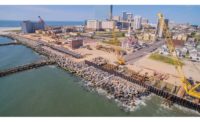Meeting To Consider Storm-Surge Barriers for New York City
A group of engineers and scientists will host a conference this spring to push for development of design criteria for storm-surge barriers to protect New York City. Global warming, rising sea levels and more frequent and violent storms mean the city inevitably will face a devastating hurricane, says conference organizer Douglas Hill, a consulting engineer and adjunct lecturer at the School of Marine and Atmospheric Sciences at Stony Brook University, Stony Brook, N.Y. Hill is working with the American Society of Civil Engineers N.Y. Metropolitan Section’s Infrastructure Group and the New York Academy of Sciences, as well as with municipal and industry supporters. It will be held March 30-31 at the Polytechnic Institute of New York University, in Brooklyn.
“First we have to show it is doable and then find out whether people like the concept and whether it’s worth trying,” explains Jagtar Khinda, chairman of the ASCE’s local infrastructure group. “It could be a very important issue for us to handle.”
Hill says three surge barriers could protect much of the city: one across the Verrazano Narrows, the mile-wide entrance to the harbor between Brooklyn and Staten Island, and two smaller barriers, one at the upper end of the East River where it meets Long Island Sound and another near Perth Amboy at the mouth of the Arthur Kill, between Staten Island and New Jersey. Hill projects a cost of $5 billion, based on comparable barriers in the Netherlands and England. “The question is whether people can be convinced it is important and worth it,” Hill says.
Hurricanes have brought surges to the area before, most recently in 1938 when a hurricane hit north of the city with a broad, 25-ft surge that caused enormous damage on Long Island and throughout New England, killing 682 people.

